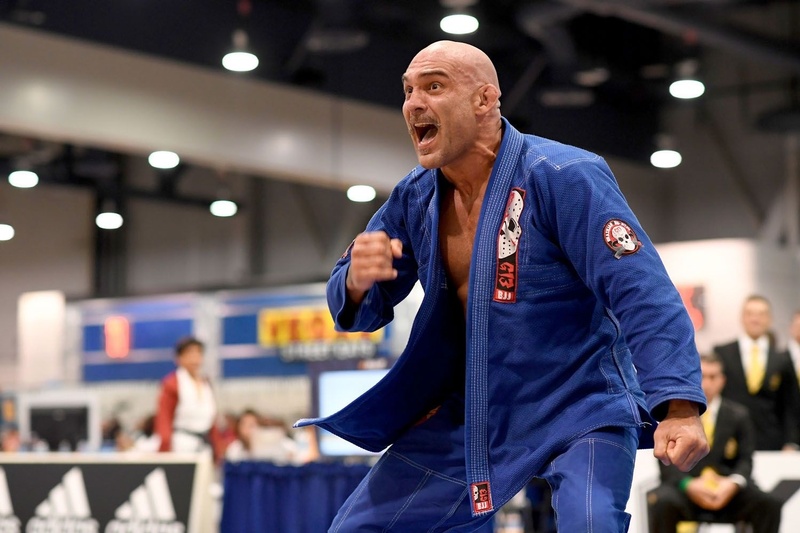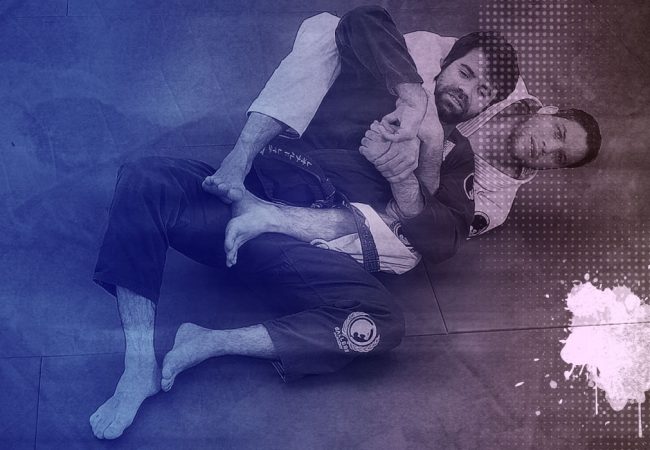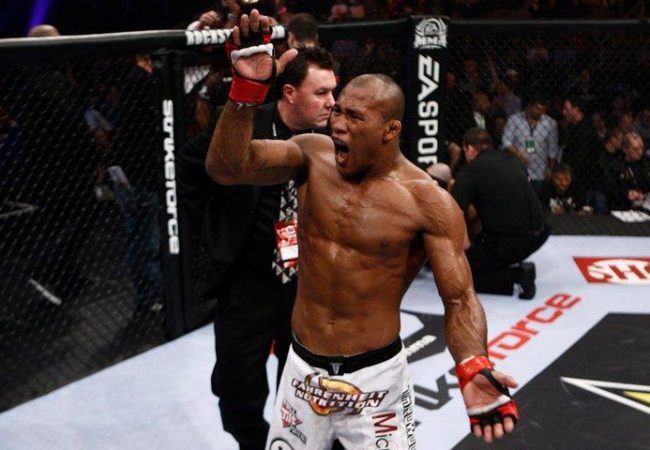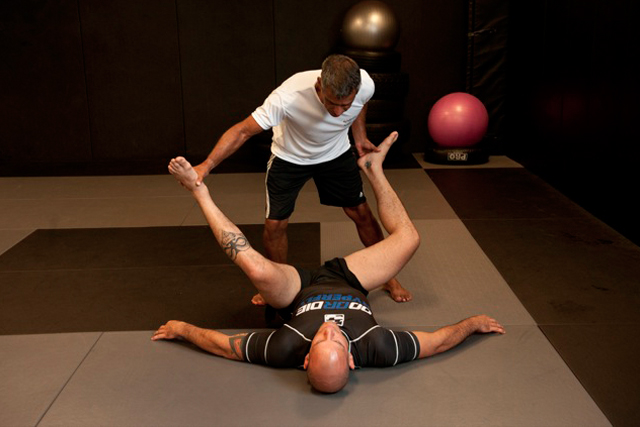A respected teacher and voracious competitor, with many titles conquered in Brazil and abroad, Roberto Godoi has reached the mark of three decades of a firm commitment with BJJ. The road has been long and littered with challenges, but Godoi, who has always liked to test himself, persisted through the years and built up his image alongside G13BJJ, the team he leads.
We talked to Godoi for issue No. 251 of Graciemag, and our chat revisited great moments of his trajectory, from his first contact with BJJ, his first gym, to the analysis of over 20 years as a black-belt, with valuable advice produced along the way.
GRACIEMAG: Firstly, lest we forget: How did your nickname, Jason, come about?
ROBERTO GODOI: [Laughs.] Good one. The nickname was born at Waldomiro “Junior” Perez’s gym. I was among the hardest sparring partners at the gym, and I almost always had on a dirty gi with one rip here and there. Also, from a young age I never had much hair, and all that coincided with the success of the films in the Friday the 13th series. When Junior would split up the sparring sessions, he’d say, “You, you train with Jason!” But the person who really made the nickname catch on, and made me own it, was a great friend of ours who developed my first gi patch. When I saw it, it was a Jason doll in a mask and gi! The younger guys have always loved it, but I myself never cared much one way or the other.
This year you celebrate 30 years of BJJ — 21 as a black-belt. What have you experienced of most memorable in all these years?
Correct. I was promoted black-belt at the end of 1996, and for 21 years I’ve proudly sported it around my waist. In 1997, I fondly remember my first matches as a black-belt, at the IBJJF’s Hawaii Pan. At the BJJ Worlds, I snatched a third place finish at Tijuca Tennis Club — it was an unparalleled moment. We were living true adventures, with caravans leaving from São Paulo by car, crashes at the Araras sierra, the suffering of the weigh-ins the day prior… I remember running for three hours around the gymnasium and still having to weigh in nude to be able to make weight and fight. We stayed at a fifth-rate hotel, all piled up. We’d get in stealthily in the wee hours so management wouldn’t pick up on it. Stories people can barely believe.
It’s been three decades of nearly nonstop competing. How do you think this constancy in tournaments helps you as a teacher and a citizen?
At 43, nowadays my body charges me for the multiple lesions I’ve had through all this time, and from that some limitations derive, but that won’t be the thing to stop me — not now, anyway! I have a passion for that feeling of stepping on the mat, of testing myself, of hearing people saying that so-and-so is in my division and he’s training to win. These are the feelings that keep lit inside me that flame from back when I was a kid, the will to train similarly to when I started out in this sport. Competing also makes me a better professional with each passing day — the search doesn’t lie in proving anything to anyone, but instead in pursuing continual evolution and balance in my jiu-jitsu, not to mention the improvement of our group as a whole.
Studying and learning never ends.
Yes, because BJJ evolves and gets modernized each year. I know I have a lot to learn and improve; thus, competing and training with my students daily forces me to stay up to date with all that’s current in our art. Besides, the championships are great for seeing friends again, having a laugh, amplifying our network of contacts — among other benefits for a teacher.
How did you get started in BJJ?
BJJ entered my life by accident. I was going to a school where there were often fights at dismissal time, and in my class there was an Argentinian boy who was good at fighting. One day this kid went to spend the end of the year in Rio de Janeiro and came back in shock. He called me and said, “If you never want to get beat up by anyone in your life again, you have to learn what I saw in Rio!” The Argentinian kid had visited a Gracie academy and told me he had been twisted every which way. “Dino,” he called me, “what you need to do is this — it’s called jiu-jitsu!”
And was it easy finding a gym in São Paulo?
I heard that Marcelo Behring, who was already a famous champion shaped by Rickson, had just arrived in SP in 1988. I went there, but the gym was popular and training there was expensive — I had no way to pay. I lucked out, because my brother came back from the U.S. and gave me a brand-new jacket. I sold the jacket for the price of three months’ training and got started. That’s where I met Waldomiro, who was Marcelo’s right-hand man and would go on to be my teacher and great friend.
What was the most memorable match of your career?
They all had value and brought some learning with them. But I don’t feel able to sum up into one moment, one personal conquest, all of my trajectory within BJJ. My biggest feat in the sport, no doubt, was the number of people and lives that I have been able to help and improve — not just those who train with me, but their families and people surrounding them as well.
Do you still remember your first school?
I was still a purple-belt in 1992 when I decided, along with a friend, to set up the first gym I ever had, in the back of my house. It was small there; there was room for about 15 students per class, and in the first month we already had 30 students training — and about ten waiting for a spot. Today, our school, G13BJJ, has been being structured more and more on an enterprise level, and it seeks to give all the support and feedback to its students and franchisee teachers. The structure is unimaginable, looking at that gym in the back of my house. Our concern these days is to take care so that G13BJJ is seen and recognized as a “martial arts school,” and our role more and more is that of good educators.
We teach both to students who think of competing and to those who dream of building businesses and of knowing how to teach and manage their own business one day. Today we are more than 7,000 students in 71 units, with 55 units in Brazil spanning São Paulo, Minas Gerais, Tocantins, Bahia and Santa Catarina. Abroad, we have five in the U.S. and one in Australia.
What tips do you have for achieving success in BJJ and reaching the black belt?
It’s hard to summarize in a few tips, because there are many variables involved. But I’d say number one is discipline, to train constantly and not give up; number two is health — in order for your machine to run well, take care of your body –; and third is self-confidence: believe in yourself, and don’t let anything or anybody say you can’t do it.
Will effort always beat out talent in BJJ?
I’m certain that talent without discipline and lots of effort leads nowhere. Since I was a kid I’ve enjoyed fighting, but I’ve always been more tenacious and perseverant than a talented guy per se. In many fights and championships I’ve won, I had success due to knowing that to be victorious, I’d first need to overcome a lack of talent I had. Today, certainly, I’m a tougher guy due to having this focus, for knowing what I’m made of. I’ve always sought to make a bigger effort today to be a better Godoi than yesterday.
One of your fortes is sticking your hand in the collar, whether it’s standing, or on the ground, always setting up an attack right away. How does that method work?
First we must remember that our matches start on the feet before they get to the ground; therefore, it’s evident that whether it’s to throw, sweep or pull guard, all positions have their preparations and nuances, especially these details of grips on collars and sleeves, so they can successfully happen.
Stood up, I strive to exert my dominant southpaw grip on my opponent’s collar, and when I achieve that, it opens up a good range of attacks and positions — details I pass on to everyone on our team. But BJJ is not always what we want, but rather what shows up at the time, so in all our routine training at G13, we focus both our strong game and our deficient side, to try to balance and elevate our game more and more.
You did seven MMA bouts, starting way back in 1995. What did you learn about BJJ and yourself by entering those rings?
Those were totally different times, where it was kind of a natural path to migrate and jump into vale-tudo at some point in your trajectory, even if just to seek that “validation” of your rank. And for me it was no different. I had many lessons within MMA, and I’m grateful for each experience that currently adds to the baggage I possess, and so I can contribute to realize the goals of my athletes, professional or not. My dream is to serve as a ramp for all my students to go much further than I have.
You, like many teachers, went through a change of image that is similar to the evolution that happened to BJJ: you used to give off an image of arrogance; now you resemble a father to your students — respectful, cordial to opponents… Is present-day Jason a man of peace?
Yes. It’s a natural process of maturing as a person, which happened parallel to the transformation of the values of BJJ as a sport and lifestyle the world over. I was the head of a group and was a “master” very early, and with that immaturity I made my mistakes, but also had my good moments. Back then, that was a stereotype attached to the majority of BJJ fighters, but without a doubt, today I’m a much better-prepared person in every way to occupy my position. A good chunk of that I owe my parents and what I learned in BJJ, due to it being this unique tool of emotional balance and rescue of moral values which, when practiced daily, shapes us and those who surround us so we can have a more harmonious, better society.
In 2001, team Godoi-Macaco, which had been achieving good results on the São Paulo circuit, split. What lessons did you get from that?
Godoi-Macaco, in its golden age, was unique, and those who lived through it, lived through it! I don’t spit on the plate I eat out of, and I am proud of everybody who went through there, without belittling so many others who worked really hard back then in SP, but we were one of the biggest actors responsible for the rise of the name “jiu-jitsu” on the map of SP and Brazil at the time. We helped build São Paulo’s jiu-jitsu, and I always believed in me, and I knew my role and value within the team. That was reflected in my self-confidence that made me not fear any breakup or start from scratch that I might need to go through. But that is BJJ in a nutshell; the art prepares us to be a champion in life. I just focused on work, without lending my ear to gossip, because while the dogs may bark, the caravan goes through anyway.
December marked the tenth anniversary of Ryan’s death. What do you think his importance was to BJJ?
The loss of Ryan represented the loss of a great fighter; he was great human material. But Ryan lost to himself. Often, the biggest battles we faces in our lives are not against opponents with physical faces or bodies that we can physically hit. For that reason, the fight is often lopsided, and thus we should not judge anybody. Controversial or not, he was always an aggregator, and considered a natural leader by his students. His move to SP, regardless of all the happenings, did indeed contribute to the development of BJJ in our state, and revealed many athletes and friends that I have for life and who currently carry his legacy and name across the planet.





